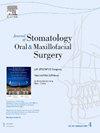优化颧骨下区微型支架放置的解剖位置和操作参数-一项CBCT研究。
IF 2
3区 医学
Q2 DENTISTRY, ORAL SURGERY & MEDICINE
Journal of Stomatology Oral and Maxillofacial Surgery
Pub Date : 2025-04-25
DOI:10.1016/j.jormas.2025.102390
引用次数: 0
摘要
本研究利用CBCT测量,评估了解剖学和手术指南的整合,以制定成功在颧下嵴(IZC)区域植入微型螺钉的现实方案。从30名成年患者中收集了720个测量数据,重点是上颌第一磨牙(U6)区域。在矢状面上创建网格系统,包括围绕U6的12个参考点,有水平和垂直的测量点。在每个参考点插入一个12毫米的虚拟IZC微型螺钉,调整角度,使窦腔穿透1毫米,骨表面外投射5毫米。插入成功被定义为与根保持至少0.5 mm的安全距离,归类为系统兼容(SC),而根接触(RC),未能实现窦渗透(SF)或窦穿孔(SP)超过1mm被归类为失败。参考区域间差异无统计学意义(p < 0.05)。在15 mm-U6MB区域,顶端插入角度为41.22°±8.67°,内侧插入角度为12.36°±2.48°,成功率最高,为55.0%。15mm - u6db区域,虽然与指南一致,但有较高的根邻近发生率(56.9%)。在17 mm区域,96.8%的病例鼻窦穿孔超过1 mm。推荐放置高度为POP上方15mm,在U6MB处顶端为40°,中间为10°,提供了稳定性和安全性的最佳平衡,符合文献指南。该研究为临床医生提供了有效的微型支架放置的证据,确保了稳定性,同时避免了关键的解剖结构。本文章由计算机程序翻译,如有差异,请以英文原文为准。
Optimizing the Anatomical Location and Procedural Parameters for Miniscrew Placement in the Infrazygomatic Region- A CBCT Study
This study evaluates the integration of anatomical and procedural guidelines to develop realistic protocols for successful miniscrew insertion in the infrazygomatic crest (IZC) region, using CBCT measurements. A total of 720 measurements were collected from 30 adult patients, focusing on the upper first molar (U6) region. A grid system was created in the sagittal plane, including 12 reference points around the U6, with horizontal and vertical measurement points. A 12-mm virtual IZC miniscrew was inserted at each reference point, with the angle adjusted for 1 mm of sinus penetration and 5 mm of projection beyond the bone surface. Insertion success was defined as maintaining a minimum 0.5 mm safe distance from the roots, classified as system-compatible (SC), while root contact (RC), failure to achieve sinus penetration (SF), or sinus perforation (SP) exceeding 1 mm were classified as failures. No significant differences were found among the reference regions (p > 0.05). The 15 mm-U6MB region, with an insertion angle of 41.22°±8.67° apically and 12.36°±2.48° mesially, had the highest success rate of 55.0 %. The 15 mm-U6DB region, while aligning with the guidelines, had a higher incidence of root proximity (56.9 %). At the 17 mm region, sinus perforations exceeded 1 mm in 96.8 % of cases. The recommended placement height of 15 mm above the POP, with a 40° apical and 10° mesial angle at U6MB, offers the best balance of stability and safety, in line with literature guidelines. This study provides clinicians with evidence for effective miniscrew placement, ensuring stability while avoiding critical anatomical structures.
求助全文
通过发布文献求助,成功后即可免费获取论文全文。
去求助
来源期刊

Journal of Stomatology Oral and Maxillofacial Surgery
Surgery, Dentistry, Oral Surgery and Medicine, Otorhinolaryngology and Facial Plastic Surgery
CiteScore
2.30
自引率
9.10%
发文量
0
审稿时长
23 days
 求助内容:
求助内容: 应助结果提醒方式:
应助结果提醒方式:


